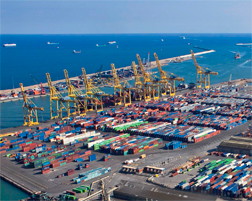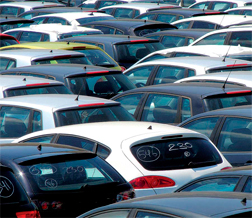Jaime García-Legaz
Secretary of State for Trade
Ministry of Finance and Competitiveness
President of ICEX Spain Exports and Investments
Madrid - Spain
Financial
Jaime García-Legaz was born in Murcia in 1968. He graduated in Economics and Business Management from CUNEF, the Financial Studies University College operating under Madrid’s Complutense University, and became a Commercial Expert and State Economist in February 1994. On 23 December 2011 his appointment as Secretary of State for Trade was confirmed by Royal Decree 1879/2011. He is married and has one daughter.
Prior to that, the current President of ICEX was an economist in the Bank of Spain’s Research Department, Deputy Director General for Public Debt in the Treasury Department of the Ministry of Economy and Finance, Economic Advisor to the Spanish Prime Minister and to the Finance Secretary of Madrid’s Autonomous Regional Government, Manager of the Office of the Secretary of State for Telecommunications, Director General for Education and Welfare in the Prime Minister’s Office, Director General for Statistics in the Autonomous Regional Government of Madrid and Head of Finance and Public Policy at the FAES Foundation think-tank. He is additionally a member of the Board of Trustees at FAES, where he was Secretary General from June 2007 to January 2012.
He has also acted as an advisor for the World Bank, the European Commission and the OECD. Between March 2008 and January 2012 he was a Member of Parliament for Murcia and Secretary of the Economy and Finance Committee of the Spanish Congress.
His professional career is rounded off by vast experience in the academic world. He has been a lecturer in Economic Policy at Madrid’s Complutense University and in International Economy at Madrid’s Autónoma University. He has taught at the School of Public Finance which is part of the CECO (the Ministry of Economy and Finance’s Trade and Economics Study Centre), and at the European University of Madrid.
García-Legaz has published some twenty articles in scientific journals in Spain and the United States. He held professorships in the Master’s Degree course at Public Management at the CEU-San Pablo University and the Master’s Degree course in Finance at CUNEF. He also lectured on the Executive MBA at the Comillas Catholic University-ICADE and the Master’s Degree in International Economy at the European University of Madrid, and he coordinated the Chair of Political Ethics and Humanities at the San Antonio University of Murcia.







“The external sector is proving to be a lifeline for the Spanish economy”
“In these times of crisis, it is the external sector that is driving the Spanish economy and will continue to do so in the years to come”. The President of ICEX says that the export base is growing geographically and in terms of businesses and industries, which means that Spain has a robust, balanced export model.
What is the mission of ICEX Spain Export and Investment?
It is to help speeding up the expansion of the Spanish export base. Spain has performed reasonably well in recent years as far as exports are concerned, but there is still one area where we need to improve: the internationalisation of our small and small-to-medium-sized businesses. Spain’s large corporations have been active internationally for the past twentyfive to thirty years.
Company size is not an issue when it comes to taking on an international dimension, or is it?
The mission of ICEX Spain Export and Investments is to help speed up the expansion of the Spanish export base
Size is important. It is not true that a company’s size does not matter or that anybody can take the leap into the international arena. When it comes to entering other markets, a large company has much more leverage and financial clout than a small one. And that is where government bodies have a role to play in helping companies that need a final push to make that overseas leap. That has a lot to do with size and although it may make more sense to help small-businesses, that does not mean every one of them. Companies need to be screened to focus on those that have the capacity to succeed when they take that leap into the international market.
New customised services
What services does ICEX provide SMEs so that they can take this leap?
Quite a few. The first and perhaps the most innovative is a programme that provides financial support to help such companies develop an international dimension. This is a new service by which ICEX contributes with EUR 12,000 and the company is required to add 12,000 more to ensure it is more fully committed to the project.
This programme firstly makes it possible to analyse the company’s capacity to enter the international market; secondly, it identifies the markets that offer prospects for success, and thirdly -and this marks an important difference from what we have been doing up to now- we help the company not only to get out there, we also help them to become established.
We have taken this step because when we studied the internationalisation figures for the last ten years we realised that only four out of every hundred companies that we had supported had actually managed to survive; and the reason was that although we had helped them to get out there, once there, no more aid was coming. So we decided to back fewer companies, but in a more coherent way, so that those that enter the international arena are much better prepared to succeed and become established in the medium term. This is our most important challenge.
Then of course our training programmes continue and we provide 250 scholarships each year for students who go on to work for exporters’ international departments and associations. Finally, we have a third focus area: information. Here too we have been introducing a number of changes. Up to now the service we offered was more or less the same for everybody. But clearly every company has its own needs, so we have set up a specialised services programme to provide information that is relevant to each specific company. It is working really well, with an annual growth rate of 40%.
| Sector | Exports | Imports | ||||
|---|---|---|---|---|---|---|
| € Million | %/Total | var. 13/12 | € Million | %/Total | var. 13/12 | |
| Total | 118,722.2 | 100.0 | 8.0 | 124,546.6 | 100.0 | -3.2 |
| Food | 17,868.6 | 15.1 | 6.7 | 13,607.9 | 10.9 | 1.1 |
| Energy products | 8,190.0 | 6.9 | 10.7 | 29,232.8 | 23.5 | -6.1 |
| Raw material | 3,184.7 | 2.7 | 4.3 | 5,031.0 | 4.0 | -2.0 |
| Non-chemical semi-finished products | 12,768.8 | 10.8 | -3.2 | 8,743.4 | 7.0 | -5.1 |
| Chemical products | 16,975.5 | 14.3 | 6.8 | 19,229.0 | 15.4 | -0.9 |
| Capital goods | 25,126.7 | 21.2 | 18.7 | 20,655.4 | 16.6 | -5.3 |
| Motor | 14,194.0 | 14.5 | 5.9 | 12,901.5 | 10.4 | 0.9 |
| Durable consumer good | 1,759.7 | 1.5 | 2.2 | 2,703.8 | 2.2 | -5.3 |
| Consumer goods manufacturers | 9,997.4 | 8.4 | 11.9 | 11,883.9 | 9.5 | 2.0 |
| Other goods | 5,656.9 | 4.8 | 0.4 | 558.1 | 0.4 | -52.0 |
| Geographical area | Exports | Imports | ||||
|---|---|---|---|---|---|---|
| € Million | %/Total | var. 13/12 | € Million | %/Total | var. 13/12 | |
| Total | 118,722.2 | 100.0 | 8.0 | 124,546.6 | 100.0 | -3.2 |
| Europe | 82,429.1 | 69.4 | 4.5 | 72,860.3 | 58.5 | -1.6 |
| America | 12,529.3 | 10.6 | 6.2 | 14,784.5 | 11.9 | -12.4 |
| Asia | 10,751.2 | 9.1 | 18.1 | 21,617.5 | 17.4 | -7.4 |
| Africa | 8,247.1 | 7.1 | 17.8 | 14,920.4 | 12.0 | 7.6 |
| Oceania | 1,258.1 | 1.1 | 36.3 | 343.2 | 0.3 | -28.4 |
| Global total | 118,722.2 | 100.0 | 8.0 | 124,546.6 | 100.0 | -3.2 |
What resources does ICEX have in order to provide these services?
Our training programmes continue and we provide 250 scholarships each year for students who go on to work for exporters’ international departments and associations
ICEX has undergone considerable budget cuts these past few years. In 2007 we had a budget of about EUR 210 million and now it is EUR 80 million, which is 60% less than five years ago. We have to make the best possible use of these funds so every euro is used as efficiently as possible. Grants used to take up a large part of the budget but that is all changing now. We are moving towards customised programmes which involve performance assessment. Whatever works, we make it work better, and whatever does not work, we drop it.
How many SMEs is ICEX currently helping?
That depends on the service we provide. Some companies go to trade fairs, some go on trade missions and others receive either general or specialised information. The figure is in the region of 30,000 companies each year.
Export credit insurance: towards a new model
“Export credit insurance is crucial for boosting Spanish exports; in fact, without it, Spanish exports would never have been able to perform so well”, says García-Legaz.
The president of ICEX confirms that “we are witnessing a change of model in credit insurance. This kind of insurance,” he adds, “was developed in Spain by CESCE, a state company with some private capital but mainly publicly-owned, and the time has come to change the system.” And he goes on to explain the reasons: “State companies are limited in what they can do, they have limitations in terms of staff and management, or their flexibility is much lower. When a state company has to compete with private companies in the international arena with such limitations, the difficulties are myriad.”
This is why, says García-Legaz, “we are in a process of transformation in which our aim is to have a private company manage this insurance via a contract or a management agreement which would be awarded through a government tender. In this way the private company that is best able to manage this service will be given the responsibility of doing so. It is a good model, but there is room for improvement and in the next few months we will see a change towards a more productive model.”
The driving force of the economy
Is the internationalisation of our businesses going to be vital to the recovery of the Spanish economy?
It already is. Last year the external sector added 2.5 percentage points to GDP growth. This means that although the economy fell by 1.4%, had it not been for the external sector it would have fallen by 3.9%. This year, the external sector will contribute between 2% and 2.7%. In these times of crisis, the external sector is proving to be a lifeline for the Spanish economy and is even creating employment.
Spanish exports have undergone the largest growth among the eurozone countries since the start of the crisis. What are your views on this?
This was great news for so many of us. Nobody thought that Spain would be able to give Europe and the rest of the world such a positive surprise with these figures, but there they are. Exports are growing in our country by more than 7%, while they are falling in Germany, France, the United Kingdom and Italy. This growth is good news because it means that Spain can regain the competitive edge it had lost and above all, that it is making an effort to open up markets, which has been a surprise for many people. Exports to Africa are growing by more than 30%, to North America by almost 20%, to South America by 14%, to Asia by more than 15% and so forth. Europe may not be on top form, as we all know, but Spanish exports are performing very well indeed.
Where are Spanish companies heading to? Is Latin America still their leading destination?
Latin America is a market that is still growing. It offers new opportunities thanks to the new free trade agreements, which enable barriers to be removed – access without tariffs. Peru is an example. The agreement signed with that country has just come into effect. Colombia is another example. South America is a market that Spanish companies feel very much at home in. Exports are growing by between 10% and even 30%, as in Brazil for instance.
Nobody thought that Spain would be able to give Europe and the rest of the world such a positive surprise with these figures, but there they are. Exports are growing in our country by more than 7%, while they are falling in Germany, France, the United Kingdom and Italy
But the good thing is that this is not the only market. Many Spanish companies are focusing on other markets: the US, Canada, Asia, which is a high-growth market. But Africa is where Spanish companies are currently most successful. It is a still unexplored market, very close to hand, and Spanish companies handle it quite skilfully. Their economies are growing by between 8% and 15% every year. Another major region is the Middle East, where Spanish exports are performing outstandingly; we are talking of about 150% or 200% growth in some countries there. Clearly this is another area that we need to look after.

Exports, a new record
In the first six months of the year exports totalled EUR 118.7 billion, a year-on-year increase of 8%. This figure had not been seen since 1971 in one single half-year and in absolute terms. Imports, on the other hand, dropped by 3.2% to EUR 124.5 billion year on year. Consequently, the trade deficit in the first half of 2013 fell by 68.8% to EUR 5.8 billion, practically a third of what it was in the same period of 2012 (EUR 18.6 billion).
The figures for the first six months of the year reveal that businesses are searching for new destinations for their exports. Most growth has been seen in countries outside the EU with an increase of 13.8% year on year. Particularly significant increases were registered in exports to Asia (18% growth); Africa (17.8%); the US (5.4%); Latin America (9.4%); and Oceania (36.3%).
Another particularly positive aspect is the increase in sales to countries with strong growth potentials, including South Africa (+64.2%), Algeria (+31%), Brazil (+40.4%), China (+13.4%), Morocco (+10.2%), and also the US (+5.4%).
Exports to more traditional destinations also made gains during the first half of the year: 4.7% growth in sales to the EU as a whole and 3.1% in the eurozone. With these figures, these regions reduced their share of the total to 62.2% and 48.6% respectively.
Most active industries
Capital goods topped the list of exporting industries in the first half of 2013 with 21.2% of the total, thus increasing its share, and a year-on-year growth of 18.7%. It is followed by the food industry (15.1% of the total with an increase of 6.7%) and car manufacturing (14.5% of the total with an increase of 5.9%).
Also of note is the dynamic performance of Spanish exports that involve added value and highly sophisticated technology such as aircraft (124.2% growth), specific industrial machinery (an advance of 48.3%), pharmaceuticals (an increase of 17.6%), engines (an increase of 12.5%), and precision apparatus (an increase of 9%).
Which industries have been most active in the overseas markets?
There are a number of “star” industries. The first one would be capital goods, which means sophisticated and high-tech machinery. This is an area where Spain is very strong. The second is the automobile industry, where Spain has once again become a major exporter. We are seeing 100% annual growth in our exports to the US, with similar figures for Turkey.
There are a number of “star” export industries: capital goods, the automotive industry, the chemical industry, and food and agriculture. So our export base is growing geographically and in terms of businesses and industries, which means that Spain has a robust, balanced export model
The chemical industry stands out too, with double-light growth. We are exporting pharmaceuticals at very high growth rates. Food and agriculture is seeing 15% growth, not only in fruit and vegetables - there is also a food and agriculture industry with a really quite strong focus on R&D. So our export base is growing geographically and in terms of businesses and industries, which means that Spain has a robust, balanced export model.
Overcoming difficulties
Apart from financial aspects, are there any other hindrances for Spanish companies seeking to enter the international market?
Yes, language skills for instance. Spain has serious shortcomings in the area of foreign languages and that limits our export capabilities. Another factor is that Spain is not as well connected by air as other countries in Europe. This requires additional effort when it comes to exports. Lastly, the image people have of Spain is not at its best at the moment, and this does not help exports either.
What basic steps would any business have to take as part of its internationalisation strategy?
First of all, the willingness to be an international company and to be convinced that doing business overseas is important and good for the company. Next, you need a competitive product. And the third factor is an organisational structure that is consistent with an international outlook. In other words, going international is not simply about setting up an international department and that’s it. Taking this step necessarily involves making far-reaching structural changes within the company.
Can that turn out to be quite complicated?
Indeed it can and not every company is prepared to take on the task. Some companies, even though they have the capacity to go international, do not even entertain the idea because it is not one of their owners’ priorities. But this has been changing. Companies are becoming increasingly aware that this is not a matter of “do I fancy doing this”. Rather, it is a question of “either I get out there, or I have no future”.
Willingness to stay
Are more companies determined to remain in the overseas market, or will they return when things get better in the domestic market?
This current crisis is different. Previous crises were shorter and although domestic market fell rapidly, it used to recover immediately. That is why I believe the “exports are fine for now but I will ditch them ASAP” attitude makes no sense right now.
Spanish companies are changing their mentality. We have had six years of crisis now and many companies are aware that exporting is not just something you do when there is a crisis in the domestic market. It is something you have to do on an ongoing basis.
The profile of our senior managers is changing too. More and more people who are becoming active in the international arena understand that it does not make much sense to leap into the overseas market and then head back home again. This crisis has many negative aspects, but also some positive ones, such as the change in the way many companies approach their businesses. Which is why in percentage terms, a good deal fewer companies will decide to dismantle their international operations when the crisis comes to an end.
Is the small and medium-sized industry repatriating any productive capacity to Spain, or is it staying overseas?
Some industries are repatriating a certain amount of productive capacity -call centres for instance- but the rest of them are not. Besides, internationalisation policies and policies designed to expand businesses’ productive capacity overseas are compatible with those aiming to attract foreign capital to Spain.
What role does ICEX play in attracting foreign investment to Spain?
ICEX has taken over the state company “Invest in Spain”, which is now one of our divisions. This integration makes good sense because certain aspects of internationalisation are closely linked to attracting overseas investment. This is very obvious in the car manufacturing industry but there are other examples.
We have had six years of crisis now and many companies are aware that exporting is not just something you do when there is a crisis in the domestic market. It is something you have to do on an ongoing basis
This division is instrumental in implementing our highly proactive policy for capturing investment. On the one hand, we play a crucial role working horizontally to show that Spain is an attractive country for foreign investment, focusing on competitiveness indexes and so on. Basically, we do our best to ensure that Spain is seen in the best possible light in all the rankings. Then there are two departments exclusively dedicated to ensuring that specific projects come to Spain. And some of them do. They may not cause a great stir, but they are coming.
What volume of investment has ICEX been able to capture?
That figure is hard to pin down. ICEX has been involved in a significant amount of the investment that comes to Spain, but I would not go so far as to say that it has been thanks to ICEX. Foreign investment in Spain has recovered considerably. Last year we captured more than 20 billion euros in investment, which is much more than what Germany, France, Italy and the United Kingdom achieved.
ICEX, the one-stop shop
At the end of 2011 ICEX became a state enterprise, with new governing bodies and new accounting and management procedures. But as far as its President is concerned, that is not the most relevant issue: “The most significant development is that ICEX is becoming the one-stop shop for internationalisation”.
ICEX Spain Export and Investments, the company’s new name, has assumed the Invest in Spain roles - the State company responsible for attracting investment to Spain. Proceedings are also under way to take over part of another body, Expansión Exterior and CECO in its entirety, a foundation dedicated to foreign trade training activities, both of which operate under the Office of the Secretary of State for Trade.
ICEX will therefore perform the duties of the bodies it is absorbing: promoting exports and investment by Spanish companies overseas, training professionals in foreign trade, and attracting and promoting foreign investment in Spain.
The “one-stop shop” will be open throughout Spain with branches in every province, and it will also include organisations that are active in other areas, such as COFIDES, a public-private company dedicated to international venture capital; CESCE, involved in export credit Insurance; the state lending institute ICO, and so on. This is very significant as it provides businesses with a single point of contact where they can obtain all the information and advice they need on internationalisation services, irrespective of who actually provides them.



